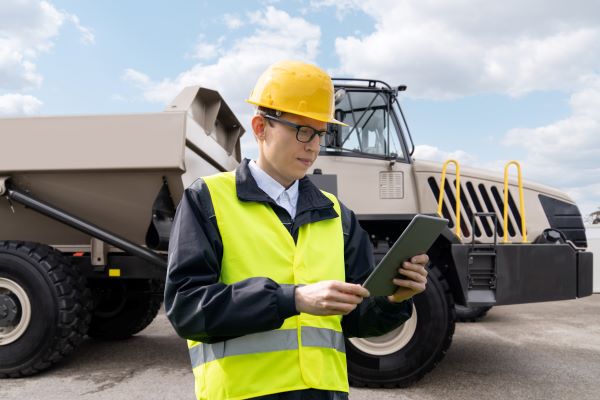Four questions about data sharing in mining and minerals and the value of connected data ecosystems
Written by Daniel Gaeta, Product Marketing Manager, AVEVA Data Hub
An interview with AVEVA Industry Marketer for Mining and Minerals, Martina Balzan
More industries are realizing the value of creating a connected data ecosystem : a network of internal and external partners—such as vendors, service providers, supply chain partners, and analytics companies—that exchange real-time operations data. Because mining and metals companies rely on mining assets in remote locations along with intricate supply chains, heavy equipment and specialized knowledge, they stand to reap particularly useful benefits from these connected data ecosystems.
I sat down with AVEVA Industry Marketer for Mining and Minerals, Martina Balzan, to learn more about how mining companies can use data-sharing to tackle some of their most pressing challenges.

1. How is sharing data and creating cloud data ecosystems helping the mining and minerals industry decarbonize?
Miners’ number-one priority continues to be reducing emissions.1 Most companies plan to reduce emissions by 30% by 2030 so that they’re on track to hit the target of zero emissions by 2050.
Right now, many mining companies are reducing scope 1 emissions by electrifying vehicles and using data and information on their owned assets, such as mobile trucks.
However, mining companies have more work to do with scope 2 and 3 emissions. They need to tackle upstream emissions from electricity, steam, heat or cooling, as well as emissions from downstream operations such as smelting and refining. Reducing these upstream and downstream emissions is where using data to collaborate with third parties—such as OEMs, consultants and service providers—can really help.
Those scope 3 emissions are such a large percentage of emissions, so they’re really where miners can get substantial emission reductions. But, because the mining value chain is so complex, they need reliable data—if they don’t have it already—to identify where they can optimize operations and get those reductions.
Once miners have reliable data, they can give teams all kinds of useful digital insights, like real-time visualization of emissions and real-time process condition monitoring on the efficiency of, for example, a furnace. Companies can also use this data to improve asset reliability with predictive maintenance that uses artificial intelligence (AI) and machine learning (ML).
2. Could you elaborate on the significance of sharing data and creating a mining and minerals industry ecosystem?
Mining companies need to improve real-time data management, operations management, and operations optimization – give users the right information, with the right context, at the right time. That information gives them a unified view from pit to port, which improves operations overall and will help them meet sustainability goals.
Once you connect data coming from the mine, the mill, and everywhere in between, your whole value chain becomes a digital nervous system that can quickly adapt to market opportunities. Your mine-to-mill processes become information loops that give you closed-loop feedback, precision control, and opportunities for continuous improvement. Fixed and mobile assets become information appliances that are self-aware and increasingly autonomous. Driving a digitally transformed mine will contribute to a connected ecosystem driving operational improvements.
3. What obstacles do mining and minerals companies run into when they start sharing data externally? How can they overcome them?
One obstacle is that some mine sites still have not fully integrated IT and OT. As they collect more and more data at the OT layer—and more users need to access it—those sites can’t get the full value that comes from integrating IT and OT. That’s why effective data sharing has become such an operational priority.
This along with a general lack of confidence on cyber security are ongoing obstacles. There is a need to increase trust in cyber secure platforms that enable safe sharing of data, while at the same time giving both IT and OT users control over where and how operational information gets shared across their ecosystem.
4. So, a mining company has decided to establish a data ecosystem—where should it begin? How can a mining company build a robust framework for a data analytics ecosystem both within and outside the organization?
Retaining talent is one of the big challenges for mining operators—so it’s important to identify key players in your ecosystem that can create a culture that attracts the right people who want to adopt new ways of working.
In addition, because many mine sites are in remote locations, site operators need to work closely with IT teams to ensure that data sharing is available at those sites, both internally and externally. That includes taking a strong, formalized approach to data governance.
Use a connected industrial ecosystem for data value creation
As Martina points out, mining and minerals companies that take advantage of an industrial data ecosystem get plenty of benefits, including:
- Scope 3 emission reductions
- Improved asset reliability
- Efficient operations
- Secure control over data sharing
AVEVA™ Data Hub lets you create your own mining data ecosystem, where you can collaborate in real time with remote stakeholders. It’s a fully managed cloud service that’s easy to scale without the need for extra IT resources. Mining companies can now easily create data-sharing communities that increase operational efficiency, sustainability and digital transformation.
[1] EY report “Top 10 business risks and opportunities for mining and metals in 2023”. ey-top-10-business-risks-and-opportunities-for-mining-and-metals-in-2023.pdf